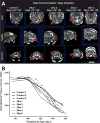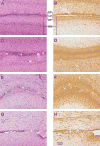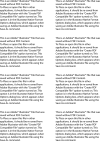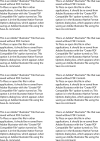Congenital Zika virus infection as a silent pathology with loss of neurogenic output in the fetal brain
- PMID: 29400709
- PMCID: PMC5839998
- DOI: 10.1038/nm.4485
Congenital Zika virus infection as a silent pathology with loss of neurogenic output in the fetal brain
Abstract
Zika virus (ZIKV) is a flavivirus with teratogenic effects on fetal brain, but the spectrum of ZIKV-induced brain injury is unknown, particularly when ultrasound imaging is normal. In a pregnant pigtail macaque (Macaca nemestrina) model of ZIKV infection, we demonstrate that ZIKV-induced injury to fetal brain is substantial, even in the absence of microcephaly, and may be challenging to detect in a clinical setting. A common and subtle injury pattern was identified, including (i) periventricular T2-hyperintense foci and loss of fetal noncortical brain volume, (ii) injury to the ependymal epithelium with underlying gliosis and (iii) loss of late fetal neuronal progenitor cells in the subventricular zone (temporal cortex) and subgranular zone (dentate gyrus, hippocampus) with dysmorphic granule neuron patterning. Attenuation of fetal neurogenic output demonstrates potentially considerable teratogenic effects of congenital ZIKV infection even without microcephaly. Our findings suggest that all children exposed to ZIKV in utero should receive long-term monitoring for neurocognitive deficits, regardless of head size at birth.
Conflict of interest statement
The authors declare no competing financial interests.
Figures




Comment in
-
A previously undetected pathology of Zika virus infection.Nat Med. 2018 Mar 6;24(3):258-259. doi: 10.1038/nm.4510. Nat Med. 2018. PMID: 29509754 Free PMC article.
References
-
- Maurice J. The Zika virus public health emergency: 6 months on. Lancet. 2016;388:449–450. - PubMed
-
- Franca GVA, et al. Congenital Zika virus syndrome in Brazil: a case series of the first 1501 livebirths with complete investigation. Lancet. 2016;388:891–897. - PubMed
-
- Mlakar J, et al. Zika Virus Associated with Microcephaly. N Engl J Med. 2016 - PubMed
Publication types
MeSH terms
Grants and funding
- T32 AI007509/AI/NIAID NIH HHS/United States
- P51 OD010425/OD/NIH HHS/United States
- R01 NS055064/NS/NINDS NIH HHS/United States
- R01 NS092339/NS/NINDS NIH HHS/United States
- U42 OD011123/OD/NIH HHS/United States
- R01 EB017133/EB/NIBIB NIH HHS/United States
- T32 HD007233/HD/NICHD NIH HHS/United States
- R01 NS085081/NS/NINDS NIH HHS/United States
- R01 AI104002/AI/NIAID NIH HHS/United States
- U19 AI100625/AI/NIAID NIH HHS/United States
- R01 AI107731/AI/NIAID NIH HHS/United States
- U54 HD083091/HD/NICHD NIH HHS/United States
- U19 AI083019/AI/NIAID NIH HHS/United States
- R01 AI100989/AI/NIAID NIH HHS/United States
- R21 OD023838/OD/NIH HHS/United States
LinkOut - more resources
Full Text Sources
Other Literature Sources
Medical

